商务英语函电课件
合集下载
国际商务英语函电课件ppt

火灾袭来时要迅速疏散逃生,不可蜂 拥而出 或留恋 财物, 要当机 立断, 披上浸 湿的衣 服或裹 上湿毛 毯、湿 被褥勇 敢地冲 出去
火灾袭来时要迅速疏散逃生,不可蜂 拥而出 或留恋 财物, 要当机 立断, 披上浸 湿的衣 服或裹 上湿毛 毯、湿 被褥勇 敢地冲 出去
火灾袭来时要迅速疏散逃生,不可蜂 拥而出 或留恋 财物, 要当机 立断, 披上浸 湿的衣 服或裹 上湿毛 毯、湿 被褥勇 敢地冲 出去
火灾袭来时要迅速疏散逃生,不可蜂 拥而出 或留恋 财物, 要当机 立断, 披上浸 湿的衣 服或裹 上湿毛 毯、湿 被褥勇 敢地冲 出去
火灾袭来时要迅速疏散逃生,不可蜂 拥而出 或留恋 财物, 要当机 立断, 披上浸 湿的衣 服或裹 上湿毛 毯、湿 被褥勇 敢地冲 出去
火灾袭来时要迅速疏散逃生,不可蜂 拥而出 或留恋 财物, 要当机 立断, 披上浸 湿的衣 服或裹 上湿毛 毯、湿 被褥勇 敢地冲 出去
火灾袭来时要迅速疏散逃生,不可蜂 拥而出 或留恋 财物, 要当机 立断, 披上浸 湿的衣 服或裹 上湿毛 毯、湿 被褥勇 敢地冲 出去
火灾袭来时要迅速疏散逃生,不可蜂 拥而出 或留恋 财物, 要当机 立断, 披上浸 湿的衣 服或裹 上湿毛 毯、湿 被褥勇 敢地冲 出去
火灾袭来时要迅速疏散逃生,不可蜂 拥而出 或留恋 财物, 要当机 立断, 披上浸 湿的衣 服或裹 上湿毛 毯、湿 被褥勇 敢地冲 出去
火灾袭来时要迅速疏散逃生,不可蜂 拥而出 或留恋 财物, 要当机 立断, 披上浸 湿的衣 服或裹 上湿毛 毯、湿 被褥勇 敢地冲 出去
火灾袭来时要迅速疏散逃生,不可蜂 拥而出 或留恋 财物, 要当机 立断, 披上浸 湿时要迅速疏散逃生,不可蜂 拥而出 或留恋 财物, 要当机 立断, 披上浸 湿的衣 服或裹 上湿毛 毯、湿 被褥勇 敢地冲 出去
《商务英语函电》课件商务英语函电第三章

equipment and supplies available from your company.” (请寄给我你公司可以提供的办公设备的完整信息和现价。)
Knowledge Input
2). 体谅Consideration 多站在对方角度考虑信函的措辞,避免问一些涉及保密的问题。如果对方 可能会对你的询问产生疑问,应该简要说明一下你的原因。 例如,在信的开头说明获得对方信息的来源。所有的组织都希望了解他们 的宣传是多么有效,你通过提供这样的信息告诉了他们,他们会很感激。 例如: Please send me a copy of Modernizing Your Kitchen, the free booklet mentioned in your advertisement in the June 14 issue of The Daily News. (请给我寄一份“使你的厨房现代化”,——你们6月14号每日新闻的广告中提
Knowledge Input
在对外贸易中,询盘通常是由买方发出以获取信息,开始贸易的。根据内容,询 盘可以分为两类,即一般询盘和具体询盘。
在一般询盘中,发盘者索要产品目录、价格表及样品等。而在具体询盘里,询盘者 索要产品的关键信息,如规格,装运期,报价,支付方式等。
询盘 询盘(inquiry)也叫询价,是指交易的一方准备购买或出售某种商品,向对方询 问买卖该商品的有关交易条件。询盘的内容可涉及:价格、规格、品质、数量、 包装、装运以及索取样品等,而多数知识询问价格。所以,业务上常把询盘称作 询价。询盘不是每笔交易必经的程序,如交易双方彼此都了解情况,不需要向对 方探寻成交条件或交易的可能性,则不必使用询盘,可直接向对方发盘。
1. 写信人想要什么? 2. 写信人需要获取什么信息? 3. 写信人应该如何安排该信函? 4. 拟写一封询盘函。
Knowledge Input
2). 体谅Consideration 多站在对方角度考虑信函的措辞,避免问一些涉及保密的问题。如果对方 可能会对你的询问产生疑问,应该简要说明一下你的原因。 例如,在信的开头说明获得对方信息的来源。所有的组织都希望了解他们 的宣传是多么有效,你通过提供这样的信息告诉了他们,他们会很感激。 例如: Please send me a copy of Modernizing Your Kitchen, the free booklet mentioned in your advertisement in the June 14 issue of The Daily News. (请给我寄一份“使你的厨房现代化”,——你们6月14号每日新闻的广告中提
Knowledge Input
在对外贸易中,询盘通常是由买方发出以获取信息,开始贸易的。根据内容,询 盘可以分为两类,即一般询盘和具体询盘。
在一般询盘中,发盘者索要产品目录、价格表及样品等。而在具体询盘里,询盘者 索要产品的关键信息,如规格,装运期,报价,支付方式等。
询盘 询盘(inquiry)也叫询价,是指交易的一方准备购买或出售某种商品,向对方询 问买卖该商品的有关交易条件。询盘的内容可涉及:价格、规格、品质、数量、 包装、装运以及索取样品等,而多数知识询问价格。所以,业务上常把询盘称作 询价。询盘不是每笔交易必经的程序,如交易双方彼此都了解情况,不需要向对 方探寻成交条件或交易的可能性,则不必使用询盘,可直接向对方发盘。
1. 写信人想要什么? 2. 写信人需要获取什么信息? 3. 写信人应该如何安排该信函? 4. 拟写一封询盘函。
商务英语函电PPT讲稿

商务英 Business Letter
Q:What should be consisted of in a business letter?
A: The business letter consists of seven standard parts:
Smith &Evans Ltd. Registered No. 596183 England 123 Upper Thames Street London EC4V
Evans@
Your ref:
Wongsheng&Co. Rm 509-511 Tongle Bldg Shennan Rd., Shenzhen China
Q:What do you think is the importance of business letter-writing?
Key Terms:
• International trade • Business correspondence • Business negotiation
Importance: Business letters are of crucial importance in the conduct of business activities. They play an essential role in a company’s correspondence with the outside world.
商务英语函电课件-肖银娣
6
Supplementary knowledge Optional parts of a business letter:
• Attention line 交由某人办理
eg: Attention: Miss Wang Hui;
外贸英语函电1PPT优秀课件

dissatisfaction. ▪ (肯定):也许在下一次,即可向贵方邮寄所需货物。 ▪ Perhaps next time we can send you what you require. ▪ (否定):非常抱歉,我方此次无法满足贵方要求。 ▪ We regret our inability to serve you at this time.
▪ Depositing money with us, our bank can pay you high dividends.
▪ Depositing money with us, you earn high dividends. (rewriting)
▪ 避免夸大其辞。比如:
▪ It is the lowest price available to you.
Francisco, we have bimonthly direct services. ▪ “bimonthly” 一词含有两个意思,即每月两次和每两个
月一次,这对于读信人 来说,就可能感到迷惑不解。
▪ 改写(rewriting):
▪ a. We have two direct sailings every month from Hong Kong to San Francisco.
第三章 商务信函书写原则 Writing Principles of the Business Letter
1
▪ 1. 礼貌 (Courtesy)
▪ 礼貌绝不是简单的客套。它是一种真诚的对“收信人的态 度”。
▪ 试比较:
▪ We have received with many thanks your letter of Oct. 7, and
▪ Depositing money with us, our bank can pay you high dividends.
▪ Depositing money with us, you earn high dividends. (rewriting)
▪ 避免夸大其辞。比如:
▪ It is the lowest price available to you.
Francisco, we have bimonthly direct services. ▪ “bimonthly” 一词含有两个意思,即每月两次和每两个
月一次,这对于读信人 来说,就可能感到迷惑不解。
▪ 改写(rewriting):
▪ a. We have two direct sailings every month from Hong Kong to San Francisco.
第三章 商务信函书写原则 Writing Principles of the Business Letter
1
▪ 1. 礼貌 (Courtesy)
▪ 礼貌绝不是简单的客套。它是一种真诚的对“收信人的态 度”。
▪ 试比较:
▪ We have received with many thanks your letter of Oct. 7, and
国际商务英语函电课件

The History and Development of Response
• Early Development: The use of relevance in international business can be traced back to the early days of the Industrial Revolution, when businesses need to communicate with suppliers and customers across national borders
Addressing the recipient property
Use the correct title, name, and contact information of the recipient
Clear subject line
Provide a conclusion and descriptive subject line to indicate the purpose of your message
• Documenting Transactions: Correspondence provides a written record of business transactions, which can be used for legal purposes in case of any disputes or misunderstandings
Courtesy
Be political and interested in your language, and show graduation and application when necessary
商务英语函电unit2-课件
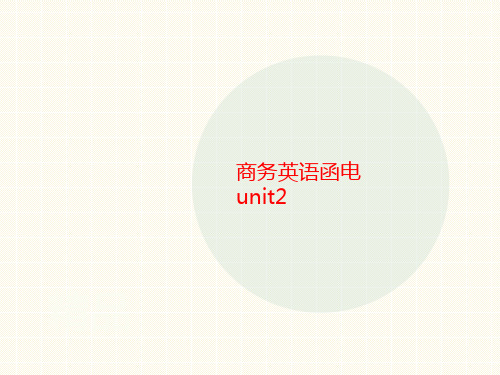
Establishing business relations is the first step in transaction in foreign trade. If a new firm, or rather a certain corporation of ours, wishes to open up a market to sell something to or buy something from firms in foreign countries, the persons in charge must first of all find out whom they are going to deal with. We should not only do everything possible to consolidate old customers but also seek new ones to enlarge our business.
the above sources, you may start contacting the prospective customers. The main methods include:
communication in writing; attendance at the export commodities fairs; contact at the exhibitions held at home or abroad; mutual visits by trade delegations and groups. Of all the above methods, the first one is widely used in business activities.
the above sources, you may start contacting the prospective customers. The main methods include:
communication in writing; attendance at the export commodities fairs; contact at the exhibitions held at home or abroad; mutual visits by trade delegations and groups. Of all the above methods, the first one is widely used in business activities.
《商务函电》PPT课件

may request an offer. • Status enquiry: traders request information concerning the financial position, credit, reputation, and business methods of other firms.
• It should be noted that whoever makes an enquiry is not liable for the buying or the selling. The other party, in the meantime, can make no reply at all. However, according to the business practice the receiver of an enquiry will respond without delay in the usual form of a quotation, an offer, or bid.
• An enquiry is the first real step in business, usually made by the buyers without engagement to get information about the goods to be ordered, such as price, catalogue, delivery date and other terms.
11、试订单 Trial
12、欧洲主要港口 European Main Ports(EMP)
13、净价 Net Price Mark
14、商标 Trade
15、品牌 Brand Specification
• It should be noted that whoever makes an enquiry is not liable for the buying or the selling. The other party, in the meantime, can make no reply at all. However, according to the business practice the receiver of an enquiry will respond without delay in the usual form of a quotation, an offer, or bid.
• An enquiry is the first real step in business, usually made by the buyers without engagement to get information about the goods to be ordered, such as price, catalogue, delivery date and other terms.
11、试订单 Trial
12、欧洲主要港口 European Main Ports(EMP)
13、净价 Net Price Mark
14、商标 Trade
15、品牌 Brand Specification
商务英语函电课件Unit10ComplaintClaimandSettlement

them.
Introduction to Complaints and Claims
Claim refers to that in international trade, one party breaks the contract and causes losses or
damages to the other party directly or indirectly, the injured party may ask for compensation for the
Unit 10 Complaint, Claim and Settlement
BUSINESS LETTER WRITING
Ⅰ Role-play
Task C Knowing about Basic Knowledge
After finding out the commercial terms from the above dialogue, try to give explanations to your partners about
Unit 10 Complaint, Claim and Settlement
BUSINESS LETTER WRITING
Ⅰ Role-play
译 Task A Situational Communication
A:The case is too serious to be overlooked! We are in urgent need of the goods for this selling season. Under such a situation, our project will surely be delayed. B:We convey our sincere apologies to you and will try our best to make up for your loss. I’ll cable our home office and ask them to dispatch the replacements. You can rest assured that your project won’t be delayed. A:Good! B:I do hope this unpleasant incident will not affect our business in the future. As for the belated goods, we’d like to have them sent to your company. A:We appreciate your positive action towards this affair.
实用商务英语函电课件Unit 1

An introduction to the course
• 商务英语函电课是一门融国际贸易实务与英语为 一体的大专院校高年级英语课,既要讲授对外贸 易业务各个环节的知识,又要训练、培养能够磋 商业务,又能撰写函电的外贸人才。
An introduction to the course
Through lecturing on writing styles of business letters as well as business terms and different expressions, and practicing business steps involved in the foreign trade, this course is designed to train and improve students’ working capability in the foreign trade by helping them have a good command of basic foreign trade terms and upgrade skills of applying expressions commonly used in the international business line.
5. to know how to make payment, and know how to use flexible payment methods, how to view or examine letters of credit to avoid mistakes;
6. to be able to lodge a claim against the other party or settle a claim courteously/politely;
国际商务函电课件(7个ppt)(英文版)2

Yours sincerely,
We look forward to receiving your shipping advice within the next seven days.
Yours faithfully,
Proposing partial shipment: Dear Sirs, Thank you for your letter of 5 April regarding your order
Yours faithfully,
Export Manager
Advising Shipment:
Dear sirs,
Thank you for your letter of 1 August enquiring about the shipment of your order under L/C No.xx.
Please accept my apology for the delay which has been caused by the unavailability of shipping space from Bombay to London.
The matter was, however, in hand and your consignment was shipped yesterday on board s.s. Pandit which is sailing directly to London. I enclose one set of shipping documents comprising:
(1)to confirm the charter party and booking note;
(2)to urge an early shipment;
We look forward to receiving your shipping advice within the next seven days.
Yours faithfully,
Proposing partial shipment: Dear Sirs, Thank you for your letter of 5 April regarding your order
Yours faithfully,
Export Manager
Advising Shipment:
Dear sirs,
Thank you for your letter of 1 August enquiring about the shipment of your order under L/C No.xx.
Please accept my apology for the delay which has been caused by the unavailability of shipping space from Bombay to London.
The matter was, however, in hand and your consignment was shipped yesterday on board s.s. Pandit which is sailing directly to London. I enclose one set of shipping documents comprising:
(1)to confirm the charter party and booking note;
(2)to urge an early shipment;
高教社2023国际商务英语函电教学课件chapter 4

We are also enclosing our latest catalogue for your reference.
Yours sincerely
Dear Mr. Smith:
We have learnt from the Bank of China, Shanghai Branch that you are one of the leading importers of canned foodstuffs. We wish to inform you that we specialize in this line, and shall be pleased to enter into direct trade relations with you.
You can also find our latest catalogue as attached. These items are newly developed models in UK market, which enjoys good popularity in your market. Please contact us for future information. Looking forward to proceed for future business relationship.
• Build your own website • B2B platform • Ground promotion • Search engines:Google、Yahoo、Yandex • Trade directory or list • Attending a trade show • Social media platforms: Facebook, LinkedIn, Twitter, Instagram
Yours sincerely
Dear Mr. Smith:
We have learnt from the Bank of China, Shanghai Branch that you are one of the leading importers of canned foodstuffs. We wish to inform you that we specialize in this line, and shall be pleased to enter into direct trade relations with you.
You can also find our latest catalogue as attached. These items are newly developed models in UK market, which enjoys good popularity in your market. Please contact us for future information. Looking forward to proceed for future business relationship.
• Build your own website • B2B platform • Ground promotion • Search engines:Google、Yahoo、Yandex • Trade directory or list • Attending a trade show • Social media platforms: Facebook, LinkedIn, Twitter, Instagram
高教社2023国际商务英语函电教学课件chapter 5

Dear Sirs
We have received a letter from the Auto Engineering Co., Ltd. in Nigeria, expressing their desire to enter into business relation with us on condition that we allow them a standing credit of USD50, 000 to start business. As stated in their letter, their reference is the National Bank of Nigeria, Ibadan.
future.
We hope you will agree to allow us open account facilities with, say, quarterly settlements. This arrangement would save us the inconvenience of making separate payments on Invoice.
We should be very pleased if you would assist us in this respect, and we can assure you that any information you may give us will be treated as confidencial.
information request Promising
Yours sincerelyYours sincerely
Replies to Credit Requests
• replies
商务英语函电课件Unit8Shipment

Question 1
Hale Waihona Puke Howdoyou
understand about
shipment and delivery
in foreign trade?
Question 2
BUSINESS LETTER WRITING
Unit 8 Shipment
Unit 8 Shipment
BUSINESS LETTER WRITING
them.
Introduction to Shipment
Shipment signifies the seller’s fulfillment of the obligation to make delivery of the goods.
Carriage of goods may take place by land, inland water-way, sea, or air.
Unit 8 Shipment
Ⅰ Role-play
Task A Situational Communication
译
BUSINESS LETTER WRITING
Or else we won’t be able to catch the shopping season. B:It’s all very well for you to say that. But I must point out that our factories have a lot of back orders on hand.I’m afraid it is very difficult to improve any further on the time. A:Can’t you find some ways for an earlier delivery? It means a lot to us. If we place our goods on the market at a time when all other importers have sold theirs at profitable prices,we shall lose out. B:How’s this then? We will make an effort to advance the shipment to early May.
Hale Waihona Puke Howdoyou
understand about
shipment and delivery
in foreign trade?
Question 2
BUSINESS LETTER WRITING
Unit 8 Shipment
Unit 8 Shipment
BUSINESS LETTER WRITING
them.
Introduction to Shipment
Shipment signifies the seller’s fulfillment of the obligation to make delivery of the goods.
Carriage of goods may take place by land, inland water-way, sea, or air.
Unit 8 Shipment
Ⅰ Role-play
Task A Situational Communication
译
BUSINESS LETTER WRITING
Or else we won’t be able to catch the shopping season. B:It’s all very well for you to say that. But I must point out that our factories have a lot of back orders on hand.I’m afraid it is very difficult to improve any further on the time. A:Can’t you find some ways for an earlier delivery? It means a lot to us. If we place our goods on the market at a time when all other importers have sold theirs at profitable prices,we shall lose out. B:How’s this then? We will make an effort to advance the shipment to early May.
商务英语函电课件
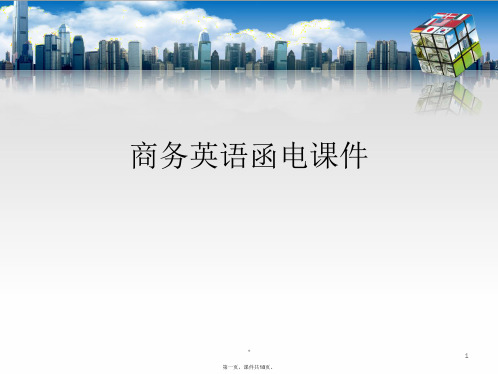
Fax:0451-82937461
Your Ref:
E-mail:heilight@ Our Ref:SM/L02-0031
Date: Sept.2.2005
S.M. Trading Co.Ltd.
Box:6041
Karachi Pakistan
Attention: Mr M Yasin Marlic
*
5
第五页,课件共18页。
2.3 Parts of a Business Letter
Q:What should be consisted of in a business letter?
A: The business letter consists of seven standard parts:
They will bring with them some samples you asked for, which would be salable in your market.
Thank you in advance for your help.
Yours Faithfully,
For Heilongjiang Light Industrial Products Imp/Exp Corporation
Attention: the writing of address in English
112 Zhongshan Road, Nangang District, Harbin China 译:中国哈尔滨南港区中山路112号 ② What’s the purpose of writing this letter?
*
6
第六页,课件共18页。
Supplementary knowledge Optional parts of a business letter:
《商务函电》PPT课件
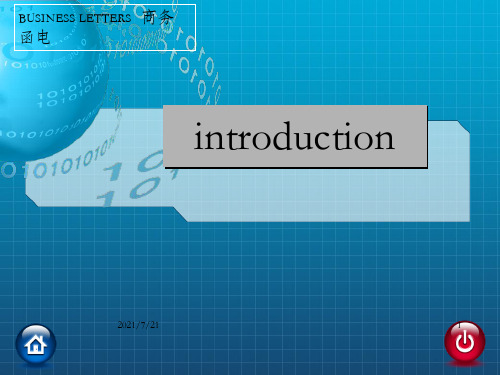
3
Some letters may contain one or more of the following, which depend on the different situation of each writing requirement: 8 — reference notation 9 — attention line 10 — subject line 11 — enclosure 12 — carbon copy 13 — postscript
each paragra件每ph格一in式段de不首nt同行ed有往an区里d别缩bl,进oc齐。ke头d 式on下e w正it文h 全all部lin齐es左o边n ,the缩le进ft式. 下正文
10
6) Complimentary Close (结束语) There are many ways of complementary close to show respect. It carries no specific meanings. Usually we keep them in pace with the salutation. When the salutation is “Dear sir (s)”, complimentary close will be “yours faithfully, yours sincerely”; when salutation uses “Gentleman (men)”, complimentary close will be “yours truly, truly yours”, etc.
Doctor John Smith, Professor Joyce Gwillian 3) 对认识的男性,可以同时写上职称甚至工作单位,如: Mr. John Smith,
Some letters may contain one or more of the following, which depend on the different situation of each writing requirement: 8 — reference notation 9 — attention line 10 — subject line 11 — enclosure 12 — carbon copy 13 — postscript
each paragra件每ph格一in式段de不首nt同行ed有往an区里d别缩bl,进oc齐。ke头d 式on下e w正it文h 全all部lin齐es左o边n ,the缩le进ft式. 下正文
10
6) Complimentary Close (结束语) There are many ways of complementary close to show respect. It carries no specific meanings. Usually we keep them in pace with the salutation. When the salutation is “Dear sir (s)”, complimentary close will be “yours faithfully, yours sincerely”; when salutation uses “Gentleman (men)”, complimentary close will be “yours truly, truly yours”, etc.
Doctor John Smith, Professor Joyce Gwillian 3) 对认识的男性,可以同时写上职称甚至工作单位,如: Mr. John Smith,
高教社2023国际商务英语函电教学课件chapter 9
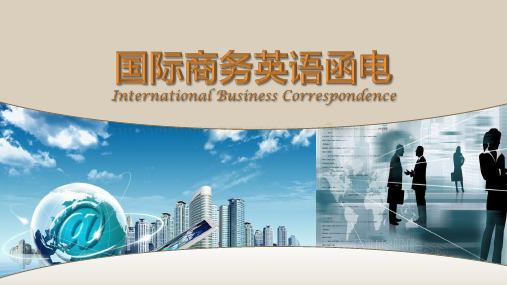
Dear Mr. Brown,
This is to refer to our Sales Confirmation No. 2358 covering 10000 dozen of bath towels of Art. No. 28909
introduction about reason for writing
We have instructed our bank, the General Commercial Bank of Venezuela to open an irrevocable documentary letter of credit in your favor. The amount is USD1275.00. This credit will be confirmed soon by our bank’s correspondent in London, you are authorized to draw a 60 days’ draft on our bank against this credit for the amount of your invoice. Your draft must be accompanied by a complete set of shipping documents, consisting of :
• You should make a remittance by T/T within a week in full
settlement of your purchase of the goods contracted.
• We are sorry to say that we can’t accomm来自date you with T/T
高教社2023国际商务英语函电教学课件chapter 11
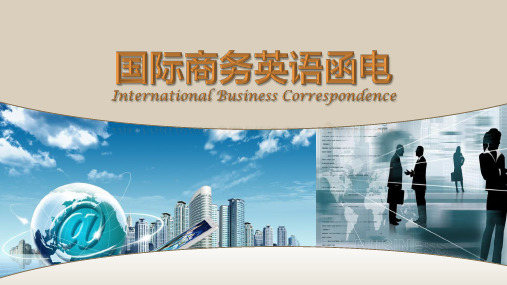
leave;
• 2. express appreciation of past experiences and/or regret at leaving; and; • 3. offer to assist with any work that you will be leaving undone or to help the person who
• 2. Continue by briefly stating your qualifications.
• 3. Showing enthusiasm, assure the employer that you are the person for the job. • 4. Conclude by requesting an interview.
Employment Correspondence
• Application letters • Follow-up letters • Testimonials • Resignation Letters
Application Letters
• A letter of application for a job is essentially a sales letter. In such a letter you are concern,
Miss Sharon Tan was employed as Shorthand Typist in this company's Sales Department when she left secretarial college in July 1999. She was promoted to my personal secretary in 2021 until she left the company in March 2021.
• 2. express appreciation of past experiences and/or regret at leaving; and; • 3. offer to assist with any work that you will be leaving undone or to help the person who
• 2. Continue by briefly stating your qualifications.
• 3. Showing enthusiasm, assure the employer that you are the person for the job. • 4. Conclude by requesting an interview.
Employment Correspondence
• Application letters • Follow-up letters • Testimonials • Resignation Letters
Application Letters
• A letter of application for a job is essentially a sales letter. In such a letter you are concern,
Miss Sharon Tan was employed as Shorthand Typist in this company's Sales Department when she left secretarial college in July 1999. She was promoted to my personal secretary in 2021 until she left the company in March 2021.
《商务英语函电》课件

实践演练
通过模拟商务场景,让学员动手实践商务英语函电的写作和应用。
案例分析
通过分析实际案例,掌握处理复杂商务情况的技巧和方法。
结束语
1 商务英语函电的重要性
商务英语函电是跨国商务沟通的重要工具,能有效促进商务合作和交流。
2 学习商务英语函电的建议
通过学习商务英语函电,提升沟通能力,拓展商务机会。
3 祝大家在商务沟通中取得成功
《商务英语函电》PPT课 件
本PPT课件详细介绍了商务英语函电的重要性和应用。通过展示函电的定义、 特点、分类,以及写作技巧、范例分析、常见问题及解决方法,使您快速掌 握商务英语函电的核心知识。
概述商务英语函电
定义
商务英语函电是用英语进行商务沟通的书信形式,旨在传递商务信息、达成商务目的。
特点
商务英语函电需要准确、简洁、规范,注重礼貌和正式性,遵循国际商务惯例。
希望通过本课件的学习,能够帮助大家在商务沟通中取得更好的成果。
分类
商务英语函电可以分为询盘函、报价函、订单函、支付函、投诉函、道歉函等多种类型。
商务英语函电的写作技巧
结构
商务英语函电通常包含称呼、 主体、结尾三个部分,每个部 分有特定的内容和格式。
语言
商务英语函电需要使用简洁明 了的商务词汇和句式,注重表 达准确、客观、礼貌。
格式
商务英语函电需要遵循特定的 格式,包括日期、收件人地址、 发件人地址、信头等重要信息。
1
发送函电的注意事项
包括选择适当的时机、合适的语气、准
函中常见错误及避免方法
2
备充足的信息等。
如拼写错误、语法错误,可通过校对和
使用辅助工具来避免。
3
函电中常用词汇及表达方法
通过模拟商务场景,让学员动手实践商务英语函电的写作和应用。
案例分析
通过分析实际案例,掌握处理复杂商务情况的技巧和方法。
结束语
1 商务英语函电的重要性
商务英语函电是跨国商务沟通的重要工具,能有效促进商务合作和交流。
2 学习商务英语函电的建议
通过学习商务英语函电,提升沟通能力,拓展商务机会。
3 祝大家在商务沟通中取得成功
《商务英语函电》PPT课 件
本PPT课件详细介绍了商务英语函电的重要性和应用。通过展示函电的定义、 特点、分类,以及写作技巧、范例分析、常见问题及解决方法,使您快速掌 握商务英语函电的核心知识。
概述商务英语函电
定义
商务英语函电是用英语进行商务沟通的书信形式,旨在传递商务信息、达成商务目的。
特点
商务英语函电需要准确、简洁、规范,注重礼貌和正式性,遵循国际商务惯例。
希望通过本课件的学习,能够帮助大家在商务沟通中取得更好的成果。
分类
商务英语函电可以分为询盘函、报价函、订单函、支付函、投诉函、道歉函等多种类型。
商务英语函电的写作技巧
结构
商务英语函电通常包含称呼、 主体、结尾三个部分,每个部 分有特定的内容和格式。
语言
商务英语函电需要使用简洁明 了的商务词汇和句式,注重表 达准确、客观、礼貌。
格式
商务英语函电需要遵循特定的 格式,包括日期、收件人地址、 发件人地址、信头等重要信息。
1
发送函电的注意事项
包括选择适当的时机、合适的语气、准
函中常见错误及避免方法
2
备充足的信息等。
如拼写错误、语法错误,可通过校对和
使用辅助工具来避免。
3
函电中常用词汇及表达方法
- 1、下载文档前请自行甄别文档内容的完整性,平台不提供额外的编辑、内容补充、找答案等附加服务。
- 2、"仅部分预览"的文档,不可在线预览部分如存在完整性等问题,可反馈申请退款(可完整预览的文档不适用该条件!)。
- 3、如文档侵犯您的权益,请联系客服反馈,我们会尽快为您处理(人工客服工作时间:9:00-18:30)。
Letterhead A letterhead includes the sender’s name and address, postcode, number of telephone, telex and fax, E-mail address, etc. It is usually printed on the top centre or typed on the right side of the paper.
商务英语函电
高职高专 ppt 课件
Parts of a Business letter
1. Letterhead(信头) 2. Reference and Date Line(编号和日期) 3. Inside Name and Address(封内名称和地 址) 4. Salutation(称呼) 5. Letter Body(正文) 6. Complimentary Close(结尾敬语) 7. Signature(签名)
1 2 3 4 5 6
Learning Aims Background Information
Letter
Fax
Email
Others
Learning Aims
Have a concept of several most popular business letter forms in modern society; Know the basic layout, format, components and writing principles of business letters; Learn how to address an envelope; Get to know some other common communication methods, like Skype and MSN.
Functions of Each Part
Complime ntary Closure The complimentary closure ends a letter in a polite way. It is usually placed two lines below the last line of the body of a letter. The main words in complimentary closure are as follows: sincerely, faithfully, cordially, respectfully and truly. Usually, we use 1) Yours Faithfully, If you do not know the name of the person, end the letter this way. 2) Yours Sincerely, If you know the name of the person, end the letter this way. See TIPS for more information. The writer’s signature consists of a handwritten signature and a typewritten signature. When typing a letter, sign your name below the complimentary closure, then print it underneath the signature, followed by your title/position. Signature can either be Chinese or English, and should contain your own style of writing.
Generally, the inside name and address should include some or all parts of the following: the receiver’s name and title, company name, street address, city, state/province, postcode and country. It appears on the left margin and usually starts two to four lines below the last line of the letterhead.
书名:商务英语函电 ISBN: 978-7-111-41047-8 作者:王维平 出版社:机械工业出版社 本书配有电子课件
商务英语函电
高职高专 ppt 课件
Chapter 1 Fundamentals of Business Communication
商务英语函电
高职高专 ppt 课件
Contents
Signature
Functions of Each Part
Attention Line The attention line is used to name the specific individual the letter is addressed to. It is usually placed between the inside address and the salutation or within the inside address and centered over the body of a letter in the indented style. The subject line is the general idea of a letter. It is usually placed one or two lines below the salutation and centered over the body of a letter in the indented style. The initials of the person who types the letter should appear in business letters. If the dictator’s name is not typed in the signature area, the reference notation shows the initials of both the dictator and the typist. It is placed two or three lines below the signature.
Inside Name and Address
商务英语函电
高职高专 ppt 课件
Functions of Each Part
Salutation Two lines below the inside name and address of a letter is the salutation. The customary formal greeting in a business letter is “Dear Sir” or “Dear Madam” (“Dear Sirs”, “Dear Mesdames” for two or more people). It is always advisable to try to find out a name. If you know the name, use the title (Mr., Mrs., Miss or Ms, Dr, etc.) and the surname only.
商务英语函电
高职高专 ppt 课件
Letter 1
Letter head
Reference Date
and
Inside name and Address
Salutation
Letosure
Signature
商务英语函电
高职高专 ppt 课件
Functions of Each Part
Letter Body
The part expresses the writer’s idea, opinion, purpose and wishes, etc. It usually begins one or two lines below the salutation. Lines within a paragraph should be single-spaced and double-spaced between paragraphs. The first paragraph should be short and state the purpose of the letter -to make an enquiry, complain, request something, etc. The paragraph or paragraphs in the middle of the letter should contain the relevant information behind the writing of the letter. Most letters in English are not very long, so keep the information to the essentials and concentrate on organizing it in a clear and logical manner rather than expanding too much. The last paragraph of a formal letter should state what action you expect the recipient to take -- to refund, send you information, etc.
Reference and Date
The reference is helpful for filing or searching. It may include a file number, department code or the initials of the signer followed by the typist of the letter. They are marked “Our Ref.” and “Your Ref.” to avoid confusion. They are typed immediately below the letterhead. The date should always be written in standard form: September 3 (rd), 2012; or 3 (rd) September, 2012 for British, for example. All number form(3/9/2012)should be avoided.
商务英语函电
高职高专 ppt 课件
Parts of a Business letter
1. Letterhead(信头) 2. Reference and Date Line(编号和日期) 3. Inside Name and Address(封内名称和地 址) 4. Salutation(称呼) 5. Letter Body(正文) 6. Complimentary Close(结尾敬语) 7. Signature(签名)
1 2 3 4 5 6
Learning Aims Background Information
Letter
Fax
Others
Learning Aims
Have a concept of several most popular business letter forms in modern society; Know the basic layout, format, components and writing principles of business letters; Learn how to address an envelope; Get to know some other common communication methods, like Skype and MSN.
Functions of Each Part
Complime ntary Closure The complimentary closure ends a letter in a polite way. It is usually placed two lines below the last line of the body of a letter. The main words in complimentary closure are as follows: sincerely, faithfully, cordially, respectfully and truly. Usually, we use 1) Yours Faithfully, If you do not know the name of the person, end the letter this way. 2) Yours Sincerely, If you know the name of the person, end the letter this way. See TIPS for more information. The writer’s signature consists of a handwritten signature and a typewritten signature. When typing a letter, sign your name below the complimentary closure, then print it underneath the signature, followed by your title/position. Signature can either be Chinese or English, and should contain your own style of writing.
Generally, the inside name and address should include some or all parts of the following: the receiver’s name and title, company name, street address, city, state/province, postcode and country. It appears on the left margin and usually starts two to four lines below the last line of the letterhead.
书名:商务英语函电 ISBN: 978-7-111-41047-8 作者:王维平 出版社:机械工业出版社 本书配有电子课件
商务英语函电
高职高专 ppt 课件
Chapter 1 Fundamentals of Business Communication
商务英语函电
高职高专 ppt 课件
Contents
Signature
Functions of Each Part
Attention Line The attention line is used to name the specific individual the letter is addressed to. It is usually placed between the inside address and the salutation or within the inside address and centered over the body of a letter in the indented style. The subject line is the general idea of a letter. It is usually placed one or two lines below the salutation and centered over the body of a letter in the indented style. The initials of the person who types the letter should appear in business letters. If the dictator’s name is not typed in the signature area, the reference notation shows the initials of both the dictator and the typist. It is placed two or three lines below the signature.
Inside Name and Address
商务英语函电
高职高专 ppt 课件
Functions of Each Part
Salutation Two lines below the inside name and address of a letter is the salutation. The customary formal greeting in a business letter is “Dear Sir” or “Dear Madam” (“Dear Sirs”, “Dear Mesdames” for two or more people). It is always advisable to try to find out a name. If you know the name, use the title (Mr., Mrs., Miss or Ms, Dr, etc.) and the surname only.
商务英语函电
高职高专 ppt 课件
Letter 1
Letter head
Reference Date
and
Inside name and Address
Salutation
Letosure
Signature
商务英语函电
高职高专 ppt 课件
Functions of Each Part
Letter Body
The part expresses the writer’s idea, opinion, purpose and wishes, etc. It usually begins one or two lines below the salutation. Lines within a paragraph should be single-spaced and double-spaced between paragraphs. The first paragraph should be short and state the purpose of the letter -to make an enquiry, complain, request something, etc. The paragraph or paragraphs in the middle of the letter should contain the relevant information behind the writing of the letter. Most letters in English are not very long, so keep the information to the essentials and concentrate on organizing it in a clear and logical manner rather than expanding too much. The last paragraph of a formal letter should state what action you expect the recipient to take -- to refund, send you information, etc.
Reference and Date
The reference is helpful for filing or searching. It may include a file number, department code or the initials of the signer followed by the typist of the letter. They are marked “Our Ref.” and “Your Ref.” to avoid confusion. They are typed immediately below the letterhead. The date should always be written in standard form: September 3 (rd), 2012; or 3 (rd) September, 2012 for British, for example. All number form(3/9/2012)should be avoided.
